Hyundai Santa Fe 2009 Owner's Manual - RHD (UK, Australia)
Manufacturer: HYUNDAI, Model Year: 2009, Model line: Santa Fe, Model: Hyundai Santa Fe 2009Pages: 269, PDF Size: 9.78 MB
Page 171 of 269
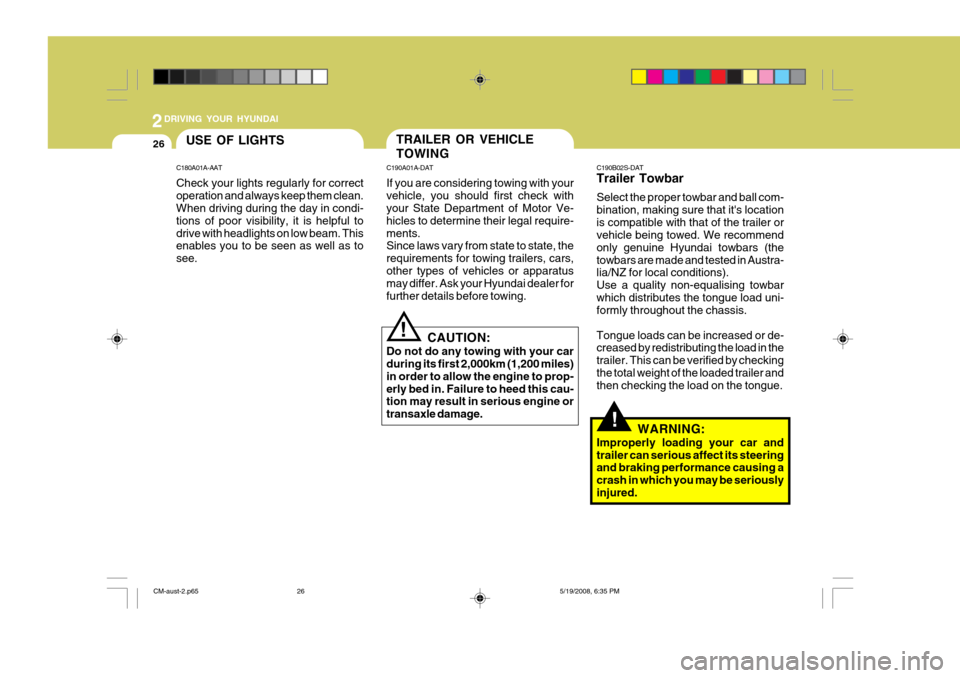
2DRIVING YOUR HYUNDAI
26
!
C190B02S-DAT Trailer Towbar Select the proper towbar and ball com- bination, making sure that it's locationis compatible with that of the trailer or vehicle being towed. We recommend only genuine Hyundai towbars (thetowbars are made and tested in Austra- lia/NZ for local conditions). Use a quality non-equalising towbarwhich distributes the tongue load uni- formly throughout the chassis. Tongue loads can be increased or de- creased by redistributing the load in the trailer. This can be verified by checkingthe total weight of the loaded trailer and then checking the load on the tongue.
WARNING:
Improperly loading your car and trailer can serious affect its steering and braking performance causing a crash in which you may be seriouslyinjured.
TRAILER OR VEHICLE TOWING
C190A01A-DAT If you are considering towing with your vehicle, you should first check with your State Department of Motor Ve- hicles to determine their legal require-ments. Since laws vary from state to state, the requirements for towing trailers, cars,other types of vehicles or apparatus may differ. Ask your Hyundai dealer for further details before towing.
CAUTION:
Do not do any towing with your car during its first 2,000km (1,200 miles) in order to allow the engine to prop-erly bed in. Failure to heed this cau- tion may result in serious engine or transaxle damage.
!
USE OF LIGHTS
C180A01A-AAT Check your lights regularly for correct operation and always keep them clean. When driving during the day in condi- tions of poor visibility, it is helpful todrive with headlights on low beam. This enables you to be seen as well as to see.
CM-aust-2.p65 5/19/2008, 6:35 PM
26
Page 172 of 269
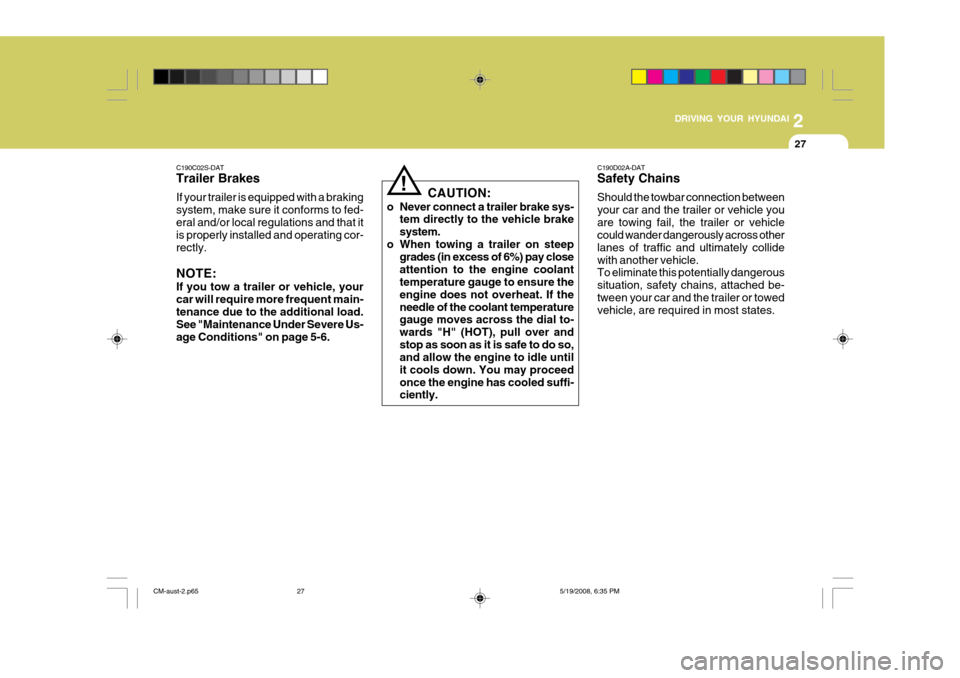
2
DRIVING YOUR HYUNDAI
27
CAUTION:
o Never connect a trailer brake sys- tem directly to the vehicle brake system.
o When towing a trailer on steep grades (in excess of 6%) pay closeattention to the engine coolant temperature gauge to ensure the engine does not overheat. If theneedle of the coolant temperature gauge moves across the dial to- wards "H" (HOT), pull over andstop as soon as it is safe to do so, and allow the engine to idle until it cools down. You may proceedonce the engine has cooled suffi- ciently.
! C190D02A-DAT Safety Chains Should the towbar connection between your car and the trailer or vehicle youare towing fail, the trailer or vehicle could wander dangerously across other lanes of traffic and ultimately collidewith another vehicle. To eliminate this potentially dangerous situation, safety chains, attached be-tween your car and the trailer or towed vehicle, are required in most states.
C190C02S-DAT Trailer Brakes If your trailer is equipped with a braking system, make sure it conforms to fed-eral and/or local regulations and that it is properly installed and operating cor- rectly. NOTE: If you tow a trailer or vehicle, your car will require more frequent main-tenance due to the additional load. See "Maintenance Under Severe Us- age Conditions" on page 5-6.
CM-aust-2.p65
5/19/2008, 6:35 PM
27
Page 173 of 269
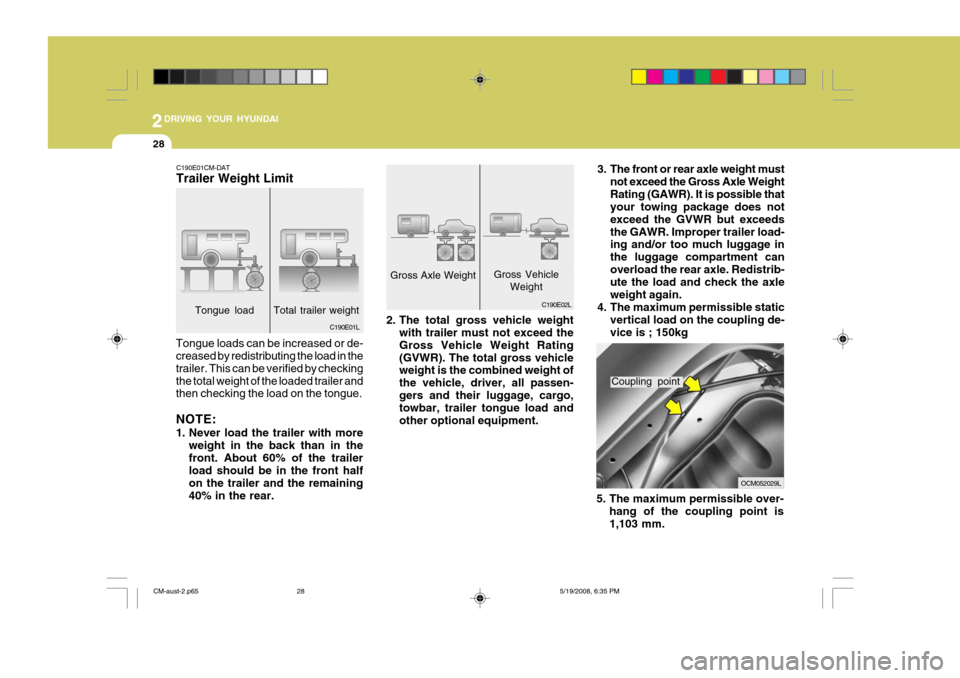
2DRIVING YOUR HYUNDAI
28
3. The front or rear axle weight mustnot exceed the Gross Axle Weight Rating (GAWR). It is possible that your towing package does not exceed the GVWR but exceedsthe GAWR. Improper trailer load- ing and/or too much luggage in the luggage compartment canoverload the rear axle. Redistrib- ute the load and check the axle weight again.
4. The maximum permissible static vertical load on the coupling de-vice is ; 150kg
2. The total gross vehicle weight with trailer must not exceed the Gross Vehicle Weight Rating(GVWR). The total gross vehicle weight is the combined weight of the vehicle, driver, all passen-gers and their luggage, cargo, towbar, trailer tongue load and other optional equipment.
Gross Axle Weight
Gross Vehicle
Weight
C190E02L
C190E01CM-DAT Trailer Weight Limit
Tongue loads can be increased or de- creased by redistributing the load in the trailer. This can be verified by checkingthe total weight of the loaded trailer and then checking the load on the tongue. NOTE:
1. Never load the trailer with more weight in the back than in the front. About 60% of the trailer load should be in the front half on the trailer and the remaining40% in the rear. C190E01L
Tongue load Total trailer weight
Coupling point
OCM052029L
5. The maximum permissible over- hang of the coupling point is 1,103 mm.
CM-aust-2.p65 5/19/2008, 6:35 PM
28
Page 174 of 269
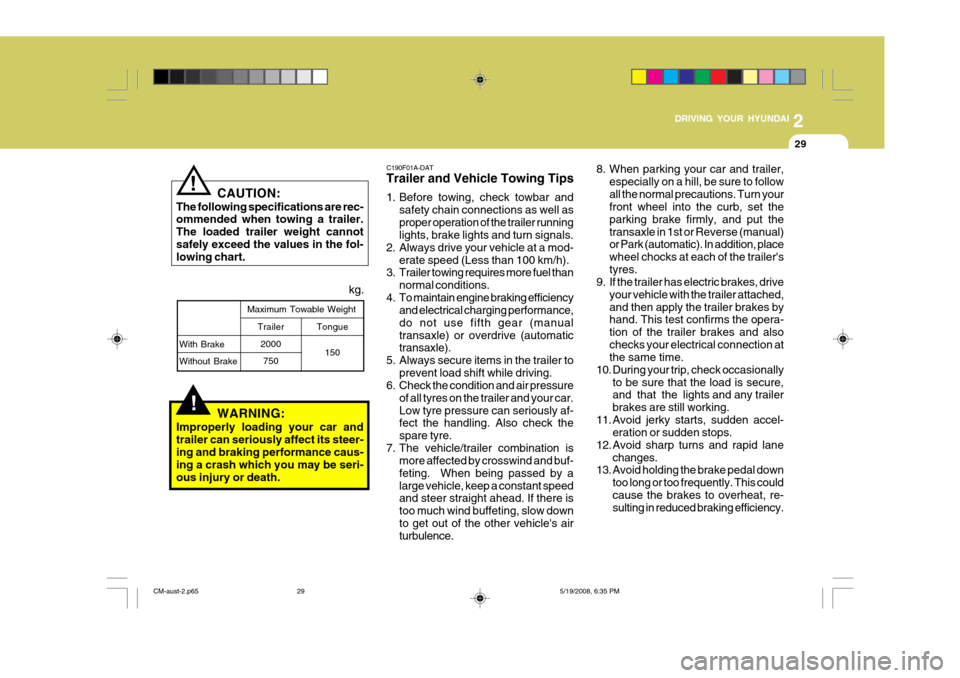
2
DRIVING YOUR HYUNDAI
29
!
C190F01A-DAT Trailer and Vehicle Towing Tips
1. Before towing, check towbar and
safety chain connections as well as proper operation of the trailer running lights, brake lights and turn signals.
2. Always drive your vehicle at a mod- erate speed (Less than 100 km/h).
3. Trailer towing requires more fuel than
normal conditions.
4. To maintain engine braking efficiency and electrical charging performance, do not use fifth gear (manualtransaxle) or overdrive (automatic transaxle).
5. Always secure items in the trailer to prevent load shift while driving.
6. Check the condition and air pressure
of all tyres on the trailer and your car. Low tyre pressure can seriously af- fect the handling. Also check the spare tyre.
7. The vehicle/trailer combination is more affected by crosswind and buf-feting. When being passed by alarge vehicle, keep a constant speed and steer straight ahead. If there is too much wind buffeting, slow downto get out of the other vehicle's air turbulence. 8. When parking your car and trailer,
especially on a hill, be sure to follow all the normal precautions. Turn your front wheel into the curb, set the parking brake firmly, and put thetransaxle in 1st or Reverse (manual) or Park (automatic). In addition, place wheel chocks at each of the trailer'styres.
9. If the trailer has electric brakes, drive
your vehicle with the trailer attached,and then apply the trailer brakes by hand. This test confirms the opera- tion of the trailer brakes and alsochecks your electrical connection at the same time.
10. During your trip, check occasionally to be sure that the load is secure,and that the lights and any trailer brakes are still working.
11. Avoid jerky starts, sudden accel- eration or sudden stops.
12. Avoid sharp turns and rapid lane changes.
13. Avoid holding the brake pedal down
too long or too frequently. This couldcause the brakes to overheat, re- sulting in reduced braking efficiency.
CAUTION:
The following specifications are rec-ommended when towing a trailer. The loaded trailer weight cannotsafely exceed the values in the fol- lowing chart.
!
Maximum Towable Weight kg.
With Brake Without Brake
WARNING:
Improperly loading your car and trailer can seriously affect its steer-ing and braking performance caus- ing a crash which you may be seri- ous injury or death.
Tongue
150
Trailer
2000750
CM-aust-2.p65 5/19/2008, 6:35 PM
29
Page 175 of 269

2DRIVING YOUR HYUNDAI
30
CAUTION:
If overheating should occur when towing, (temperature gauge reads near red zone), taking the following action may reduce or eliminate theproblem.
1. Turn off the air conditioner.
2. Reduce highway speed.
3. Select a lower gear when going uphill.
4. While in stop and go traffic, place the gear selector in park or neu-tral and idle the engine at a higher speed.
!
14. When going down a hill, shift into a
lower gear and use the engine brak- ing effect. When ascending a long grade, downshift the transaxle to a lower gear and reduce speed toreduce chances of engine overload- ing and/or overheating.
15. If you have to stop while going uphill, do not hold the vehicle inplace by pressing on the accelera- tor. This can cause the automatictransaxle to overheat. Use the hand brake or footbrake.
NOTE: When towing, check transaxle fluid more frequently.
CM-aust-2.p65 5/19/2008, 6:35 PM
30
Page 176 of 269
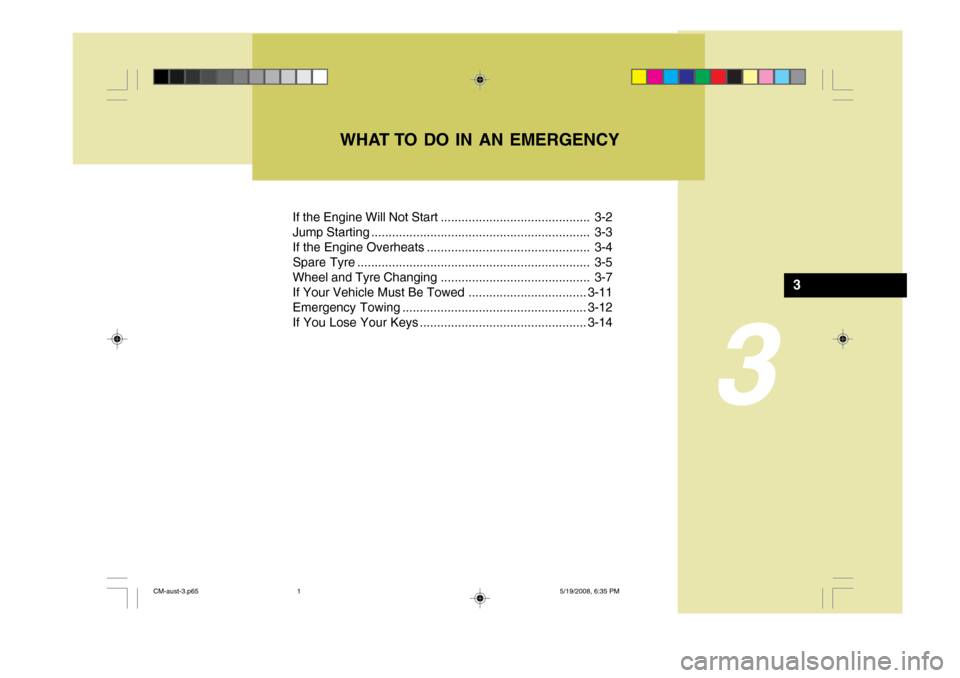
3
If the Engine Will Not Start ........................................... 3-2
Jump Starting ............................................................... 3-3
If the Engine Overheats ............................................... 3-4
Spare Tyre ................................................................... 3-5
Wheel and Tyre Changing ........................................... 3-7
If Your Vehicle Must Be Towed ..................................3-11
Emergency Towing ..................................................... 3-12
If You Lose Your K eys ................................................ 3-14
WHAT TO DO IN AN EMERGENCY
3
CM-aust-3.p65
5/19/2008, 6:35 PM
1
Page 177 of 269
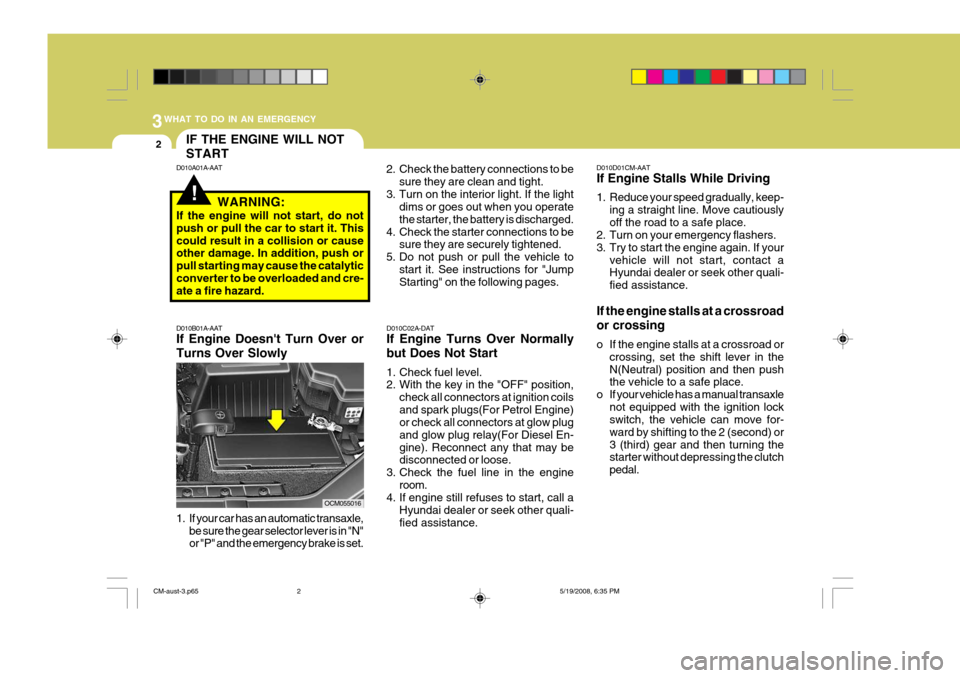
3WHAT TO DO IN AN EMERGENCY
2
!
IF THE ENGINE WILL NOT START
1. If your car has an automatic transaxle, be sure the gear selector lever is in "N" or "P" and the emergency brake is set.
D010B01A-AAT If Engine Doesn't Turn Over or Turns Over Slowly
D010A01A-AAT
D010D01CM-AAT If Engine Stalls While Driving
1. Reduce your speed gradually, keep-
ing a straight line. Move cautiously off the road to a safe place.
2. Turn on your emergency flashers.
3. Try to start the engine again. If your
vehicle will not start, contact a Hyundai dealer or seek other quali- fied assistance.
If the engine stalls at a crossroad or crossing
o If the engine stalls at a crossroad or crossing, set the shift lever in the N(Neutral) position and then push the vehicle to a safe place.
o If your vehicle has a manual transaxle not equipped with the ignition lockswitch, the vehicle can move for- ward by shifting to the 2 (second) or3 (third) gear and then turning the starter without depressing the clutch pedal.
D010C02A-DAT If Engine Turns Over Normally but Does Not Start
1. Check fuel level.
2. With the key in the "OFF" position,
check all connectors at ignition coils and spark plugs(For Petrol Engine) or check all connectors at glow plug and glow plug relay(For Diesel En-gine). Reconnect any that may be disconnected or loose.
3. Check the fuel line in the engine
room.
4. If engine still refuses to start, call a
Hyundai dealer or seek other quali- fied assistance.
WARNING:
If the engine will not start, do notpush or pull the car to start it. Thiscould result in a collision or cause other damage. In addition, push or pull starting may cause the catalyticconverter to be overloaded and cre- ate a fire hazard.
OCM0550162. Check the battery connections to be
sure they are clean and tight.
3. Turn on the interior light. If the light dims or goes out when you operate the starter, the battery is discharged.
4. Check the starter connections to be sure they are securely tightened.
5. Do not push or pull the vehicle to start it. See instructions for "Jump Starting" on the following pages.
CM-aust-3.p65 5/19/2008, 6:35 PM
2
Page 178 of 269
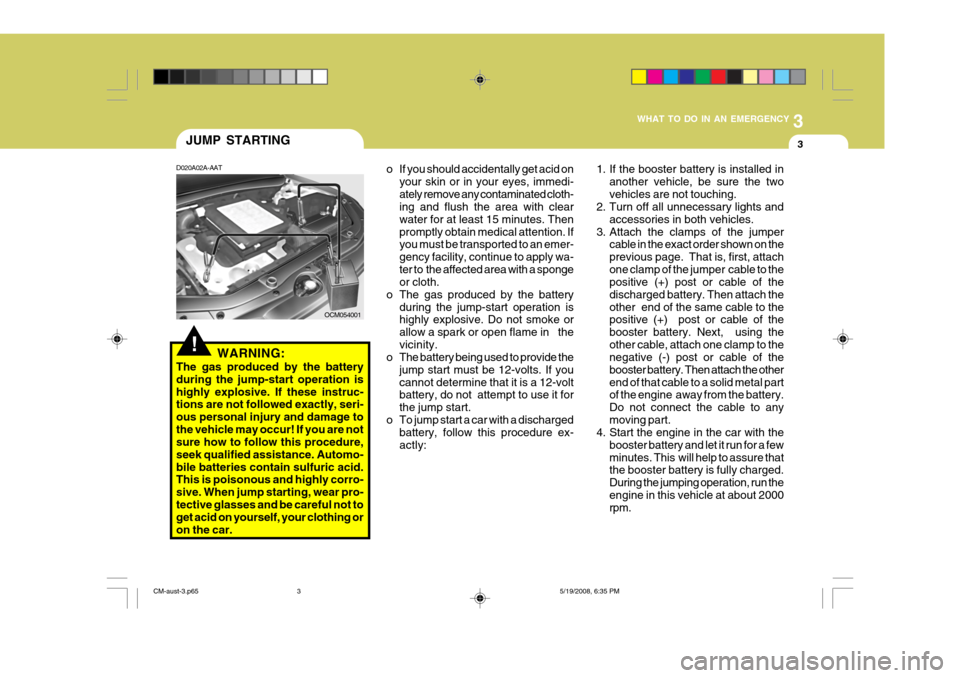
3
WHAT TO DO IN AN EMERGENCY
3
!
OCM054001
JUMP STARTING
D020A02A-AAT
WARNING:
The gas produced by the battery during the jump-start operation ishighly explosive. If these instruc- tions are not followed exactly, seri- ous personal injury and damage tothe vehicle may occur! If you are not sure how to follow this procedure, seek qualified assistance. Automo-bile batteries contain sulfuric acid. This is poisonous and highly corro- sive. When jump starting, wear pro-tective glasses and be careful not to get acid on yourself, your clothing or on the car. o If you should accidentally get acid on
your skin or in your eyes, immedi-ately remove any contaminated cloth- ing and flush the area with clear water for at least 15 minutes. Thenpromptly obtain medical attention. If you must be transported to an emer- gency facility, continue to apply wa-ter to the affected area with a sponge or cloth.
o The gas produced by the battery
during the jump-start operation ishighly explosive. Do not smoke or allow a spark or open flame in thevicinity.
o The battery being used to provide the
jump start must be 12-volts. If youcannot determine that it is a 12-volt battery, do not attempt to use it for the jump start.
o To jump start a car with a discharged battery, follow this procedure ex-actly: 1. If the booster battery is installed in
another vehicle, be sure the twovehicles are not touching.
2. Turn off all unnecessary lights and
accessories in both vehicles.
3. Attach the clamps of the jumper cable in the exact order shown on theprevious page. That is, first, attachone clamp of the jumper cable to the positive (+) post or cable of the discharged battery. Then attach theother end of the same cable to the positive (+) post or cable of the booster battery. Next, using theother cable, attach one clamp to the negative (-) post or cable of the booster battery. Then attach the otherend of that cable to a solid metal part of the engine away from the battery. Do not connect the cable to anymoving part.
4. Start the engine in the car with the
booster battery and let it run for a fewminutes. This will help to assure that the booster battery is fully charged. During the jumping operation, run theengine in this vehicle at about 2000 rpm.
CM-aust-3.p65 5/19/2008, 6:35 PM
3
Page 179 of 269
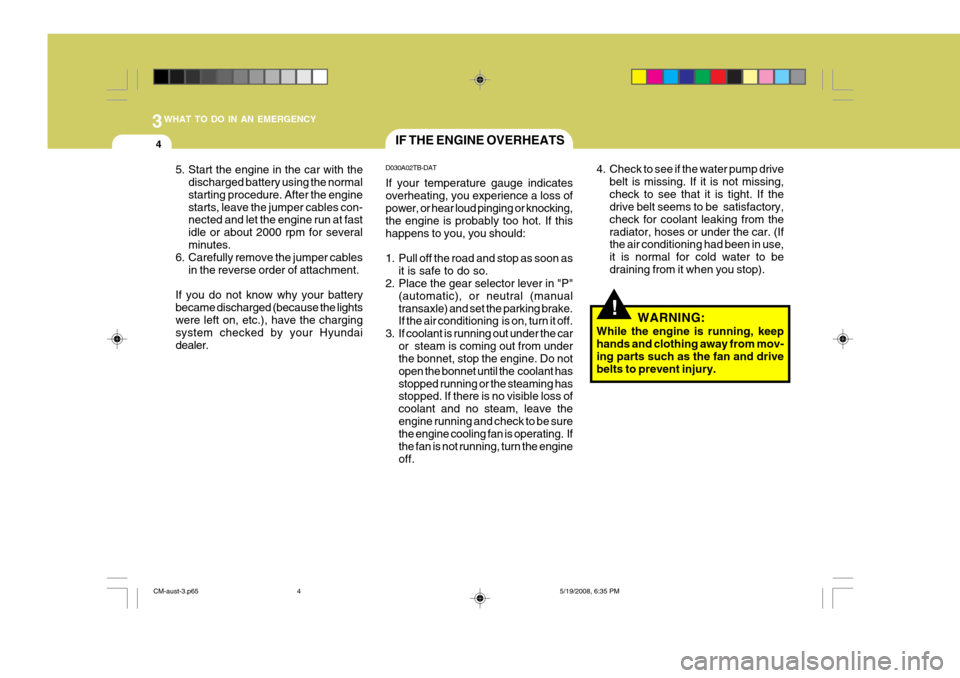
3WHAT TO DO IN AN EMERGENCY
4
!
IF THE ENGINE OVERHEATS
4. Check to see if the water pump drivebelt is missing. If it is not missing, check to see that it is tight. If the drive belt seems to be satisfactory, check for coolant leaking from theradiator, hoses or under the car. (If the air conditioning had been in use, it is normal for cold water to bedraining from it when you stop).
D030A02TB-DAT If your temperature gauge indicates overheating, you experience a loss of power, or hear loud pinging or knocking, the engine is probably too hot. If thishappens to you, you should:
1. Pull off the road and stop as soon as
it is safe to do so.
2. Place the gear selector lever in "P"
(automatic), or neutral (manual transaxle) and set the parking brake. If the air conditioning is on, turn it off.
3. If coolant is running out under the car or steam is coming out from underthe bonnet, stop the engine. Do not open the bonnet until the coolant hasstopped running or the steaming has stopped. If there is no visible loss of coolant and no steam, leave theengine running and check to be sure the engine cooling fan is operating. If the fan is not running, turn the engineoff. WARNING:
While the engine is running, keephands and clothing away from mov-ing parts such as the fan and drive belts to prevent injury.
5. Start the engine in the car with the
discharged battery using the normal starting procedure. After the enginestarts, leave the jumper cables con- nected and let the engine run at fast idle or about 2000 rpm for severalminutes.
6. Carefully remove the jumper cables
in the reverse order of attachment.
If you do not know why your batterybecame discharged (because the lightswere left on, etc.), have the charging system checked by your Hyundai dealer.
CM-aust-3.p65 5/19/2008, 6:35 PM
4
Page 180 of 269
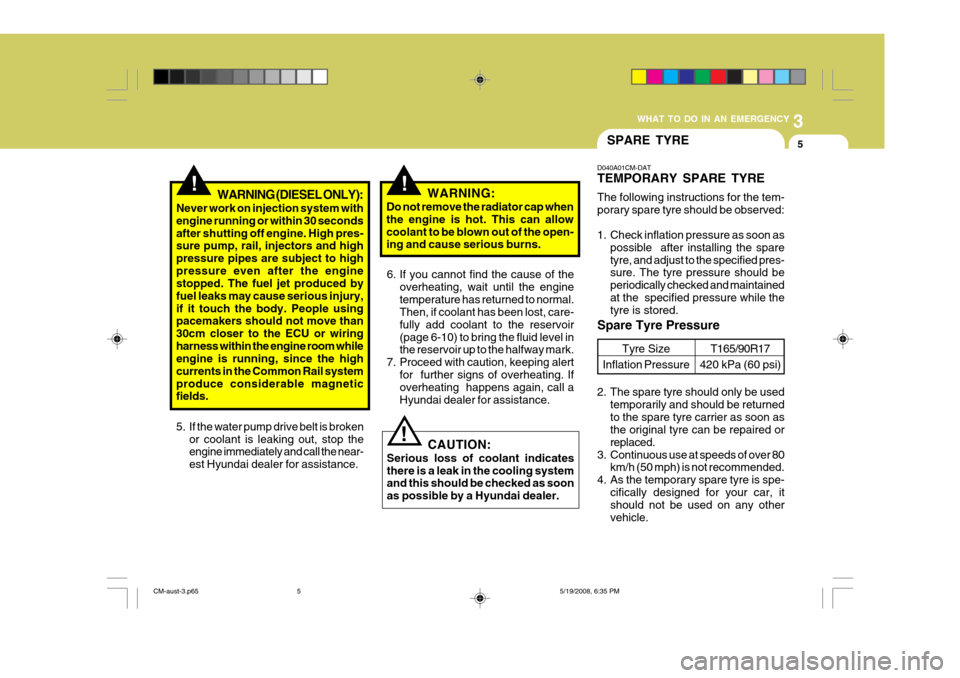
3
WHAT TO DO IN AN EMERGENCY
5
!
5. If the water pump drive belt is broken
or coolant is leaking out, stop the engine immediately and call the near- est Hyundai dealer for assistance. WARNING:
Do not remove the radiator cap whenthe engine is hot. This can allowcoolant to be blown out of the open- ing and cause serious burns.
!WARNING (DIESEL ONLY):
Never work on injection system with engine running or within 30 secondsafter shutting off engine. High pres- sure pump, rail, injectors and high pressure pipes are subject to highpressure even after the engine stopped. The fuel jet produced by fuel leaks may cause serious injury,if it touch the body. People using pacemakers should not move than 30cm closer to the ECU or wiringharness within the engine room while engine is running, since the high currents in the Common Rail systemproduce considerable magnetic fields. 6. If you cannot find the cause of the
overheating, wait until the engine temperature has returned to normal. Then, if coolant has been lost, care- fully add coolant to the reservoir(page 6-10) to bring the fluid level in the reservoir up to the halfway mark.
7. Proceed with caution, keeping alert for further signs of overheating. Ifoverheating happens again, call a Hyundai dealer for assistance.
CAUTION:
Serious loss of coolant indicatesthere is a leak in the cooling system and this should be checked as soon as possible by a Hyundai dealer.
!
SPARE TYRE
D040A01CM-DAT TEMPORARY SPARE TYRE The following instructions for the tem- porary spare tyre should be observed:
1. Check inflation pressure as soon as possible after installing the spare tyre, and adjust to the specified pres- sure. The tyre pressure should be periodically checked and maintainedat the specified pressure while the tyre is stored.
Spare Tyre Pressure
Tyre Size
Inflation PressureT165/90R17
420 kPa (60 psi)
2. The spare tyre should only be used temporarily and should be returned to the spare tyre carrier as soon as the original tyre can be repaired or replaced.
3. Continuous use at speeds of over 80 km/h (50 mph) is not recommended.
4. As the temporary spare tyre is spe-
cifically designed for your car, it should not be used on any other vehicle.
CM-aust-3.p65 5/19/2008, 6:35 PM
5